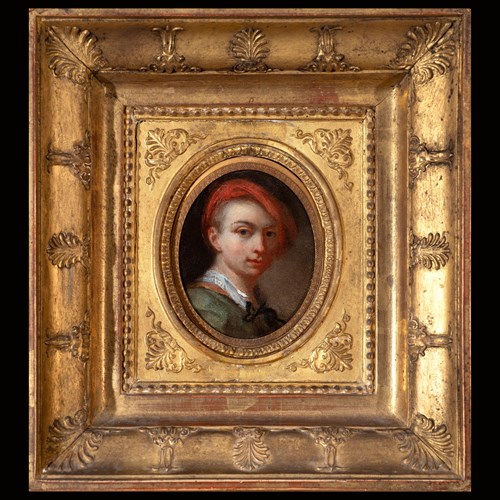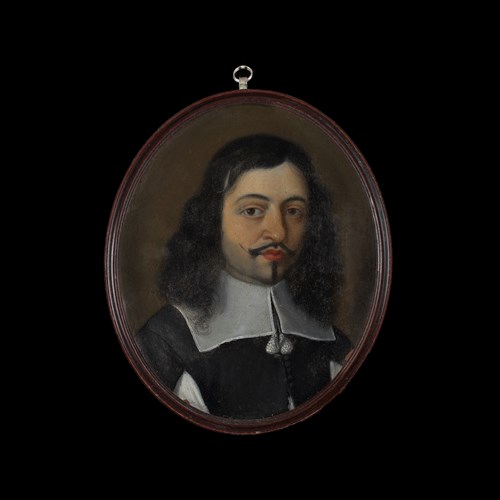Marketplace
Portrait miniature of an Officer of Light Infantry
James Leakey
Portrait miniature of an Officer of Light Infantry
The Limner Company : Portrait Miniature
Date circa 1810
Dimension 7 cm (2³/₄ inches)
This officer painted by Leakey showcases his technique of painting in oil on ivory – eschewing the traditional watercolour and bodycolour used by miniaturists since the 16th century. Painted circa 1810, the officer here was likely engaged in the Napoleonic Wars. Although he wears full uniform, there is a personal touch in that the blue patterned cloth emerging from his coat may well have been a gift on his departure from a wife or lover.
Although he was born and died in Exeter, his reputation as a miniaturist extended far beyond the borders of his Devonshire home and earned him several by-lines in Joseph Farington’s diaries of the contemporary British art world as well as an obituary in the prestigious Art Journal some fifty years later.
Part of the Art Journal’s fascination with Leakey was the link he provided back to the masters of a previous generation and they noted that he had been about to join Sir Joshua Reynold’s studio – a plan foiled by Reynold’s death. He was also apparently known to Constable, Wilkie and Callcott, all of whom admired his rustic genre studies and interior scenes. Lawrence meanwhile went so far as to call him the “English Wouwermans” perhaps because of his affection for white horses, cherubic figures and rich colouring.
Leakey’s landscapes and genre scenes, however, amounted to only a small part of his work and were completed during periods when he was not working on the portrait commissions and miniatures which supplied his main income. He was so sought after as a miniaturist that this was estimated by Farington to be as much as £800 a year. The present work was likely painted in his home town of Exeter, as in 1821 he came to London residing at 23 Newman Street. During this time, he exhibited five paintings at the Royal Academy. Many of the scenes in his oil paintings were set around Dartmouth or along the coast between Exmouth and Torbay and featured incidents from fisher-life similar to those by Thomas Luny who was resident in Teignmouth from 1807. Nevertheless Leakey’s genuine characters and ruddy, well-rounded figures clearly owe much to his skill as a miniaturist. His work is well-represented in public collections in both Exeter and London (Exeter: Royal Albert Memorial Museum and Guildhall/ Royal Devon and Exeter Hospital) and London; National Portrait Gallery.
Although he was born and died in Exeter, his reputation as a miniaturist extended far beyond the borders of his Devonshire home and earned him several by-lines in Joseph Farington’s diaries of the contemporary British art world as well as an obituary in the prestigious Art Journal some fifty years later.
Part of the Art Journal’s fascination with Leakey was the link he provided back to the masters of a previous generation and they noted that he had been about to join Sir Joshua Reynold’s studio – a plan foiled by Reynold’s death. He was also apparently known to Constable, Wilkie and Callcott, all of whom admired his rustic genre studies and interior scenes. Lawrence meanwhile went so far as to call him the “English Wouwermans” perhaps because of his affection for white horses, cherubic figures and rich colouring.
Leakey’s landscapes and genre scenes, however, amounted to only a small part of his work and were completed during periods when he was not working on the portrait commissions and miniatures which supplied his main income. He was so sought after as a miniaturist that this was estimated by Farington to be as much as £800 a year. The present work was likely painted in his home town of Exeter, as in 1821 he came to London residing at 23 Newman Street. During this time, he exhibited five paintings at the Royal Academy. Many of the scenes in his oil paintings were set around Dartmouth or along the coast between Exmouth and Torbay and featured incidents from fisher-life similar to those by Thomas Luny who was resident in Teignmouth from 1807. Nevertheless Leakey’s genuine characters and ruddy, well-rounded figures clearly owe much to his skill as a miniaturist. His work is well-represented in public collections in both Exeter and London (Exeter: Royal Albert Memorial Museum and Guildhall/ Royal Devon and Exeter Hospital) and London; National Portrait Gallery.
Date: circa 1810
Dimension: 7 cm (2³/₄ inches)
Provenance: Private Collection, UK
Plus d'œuvres d'art de la Galerie





-Portrait of a young girl, wearing a pink dress and gauze headdress_T638964936340806727.jpg?width=500&height=500&mode=pad&scale=both&qlt=90&format=jpg)


 of Standlynch (1619-70)_T638912317218987991.JPG?width=500&height=500&mode=pad&scale=both&qlt=90&format=jpg)
